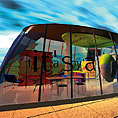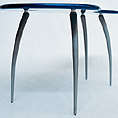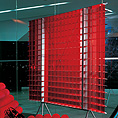











The Superdimension FridgecontinuedSolutions |
An air cycle unit may ultimately achieve a COP (coefficient of performance) comparable to a current practice freon unit but a freon unit of energy optimized design is always likely to be superior. |
What needs to be kept in perspective is that the heat load imposed on the refrigerating unit is of course a function of both cabinet size and the insulating properties of the cabinet construction. Modern practice has been to reduce the thickness of the walls principally to increase internal cabinet volume for a given external dimension. A widely used technique for the cabinet manufacture has been to foam the cabinet insulation by 'blowing' the foam into the cabinet walls with a freon so the foam will expand and fill all spaces. This has been a major source of CFC emissions. If the insulating properties of the cabinet could be increased dramatically then the energy required for a given cabinet size would be reduced roughly proportionally. This means a substantial reduction in energy consumption is possible without any improvement in COP simply by increasing the cabinet wall thickness. |
The problem with this approach is that of course this will reduce the power consumed but it will also reduce the internal dimensions of the fridge. For example an increase in wall thickness from 25 mm to 125 mm will diminish the power consumption by a factor of approximately 4-5. It will also diminish the internal volume of a 350 litre capacity fridge by about 35% depending on the geometry. Large fridges are affected less due to the square-cube law, whereby the volume increases as the cube of the dimensions but the surface area and consequently the heat gain only increases as the square of the dimensions. So if you double the dimensions of a fridge its heat gain and power consumption will increase four times but its volume will increase eight times. Consequently its specific power consumption in kwhrs/annum/litre will halve. In order to reduce heat gain but not use thickwall construction a better quality of insulation must be used. Very good insulation is found in thermos flasks which use double wall construction with the space between the walls evacuated as heat will not conduct easily through a vacuum. The heat conduction of an evacuated space may be 10 times less than an equivalent thickness of insulation. Super insulation used in cryogenic applications is even better. Vacuum insulation imposes structural loads due the difference between atmospheric pressure and the vacuum. These forces must be restrained and it is for this reason thermos flasks are circular. This is also the optimum shape for minimization of heat losses. With this technique we could reduce the heat load conservatively by a factor of 5 with out compromising internal capacity. |
Example |
For 2C internal temperature and 32C external temp =30C difference then heat gain is 15W/m2 The SD-1 has a volume of 117 litres and an area of 1.33m2 so the heat gain is 20W in 1 year (8800) = 20*8800/1000 =176 kwhrs thermal The COP of our air cycle unit is about 2 (thermal to electric including all losses) at these test conditions as calculated in our computer model. So annual energy consumption is 176/2 =88 kwhrs So specific energy consumption is 88/117 = 0.752 kwhrs/litre/annum which is about 3 times better than current best practice.For a 350 litre fridge of SD-1 design We estimate 0.52kwhrs/litre/annum which is about 4 times better than current best practice. |
We feel confident of the heat loss calculation as the losses are very similar to results obtained by researchers at the University of Sydney working on evacuated windows for buildings. |
The efficiency of the air cycle compressor was obtained by constructing a numerical simulation of our proposed design and including losses for friction, pressure drop, temperature drop in heat exchangers, electrical losses and leakage losses. Obviously the actual result cannot be confirmed until a prototype is constructed and tested. However, we take comfort in the fact that even if we are wrong by a factor of 2 in our modelling (which we feel is unlikely) our results for specific annual energy consumption will still be 1.5 times better than current practice for the 117 litre SD-1 and 2 times better for the 350 litre. |
Costs |
The cabinet is of course more expensive and considerable effort will have to be devoted to manufacturing process. We take comfort in the fact that the material cost is not significantly higher. It is also possible to make non-circular designs although their performance may be reduced however a more conventional door could substitute for the opening ram. We have a number or manufacturing method proposals to solve the seal problems and this would be an area of appropriate research along with the air cycle refrigerator. |
Anthony Kitchener |
CreditsDesign: Michael Trudgeon, Anthony Kitchener |
page: 1 | 2 |
2008 © Crowd

